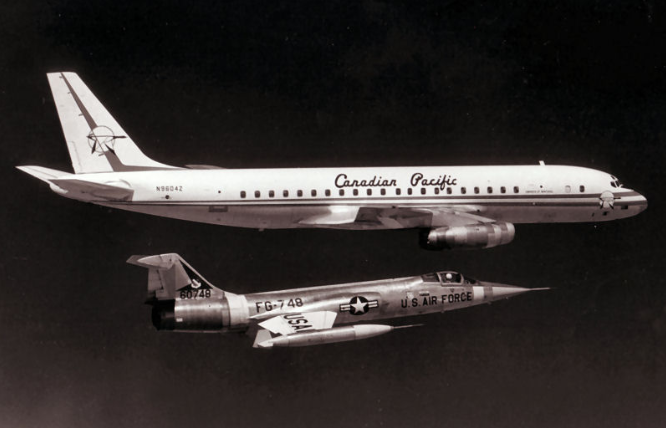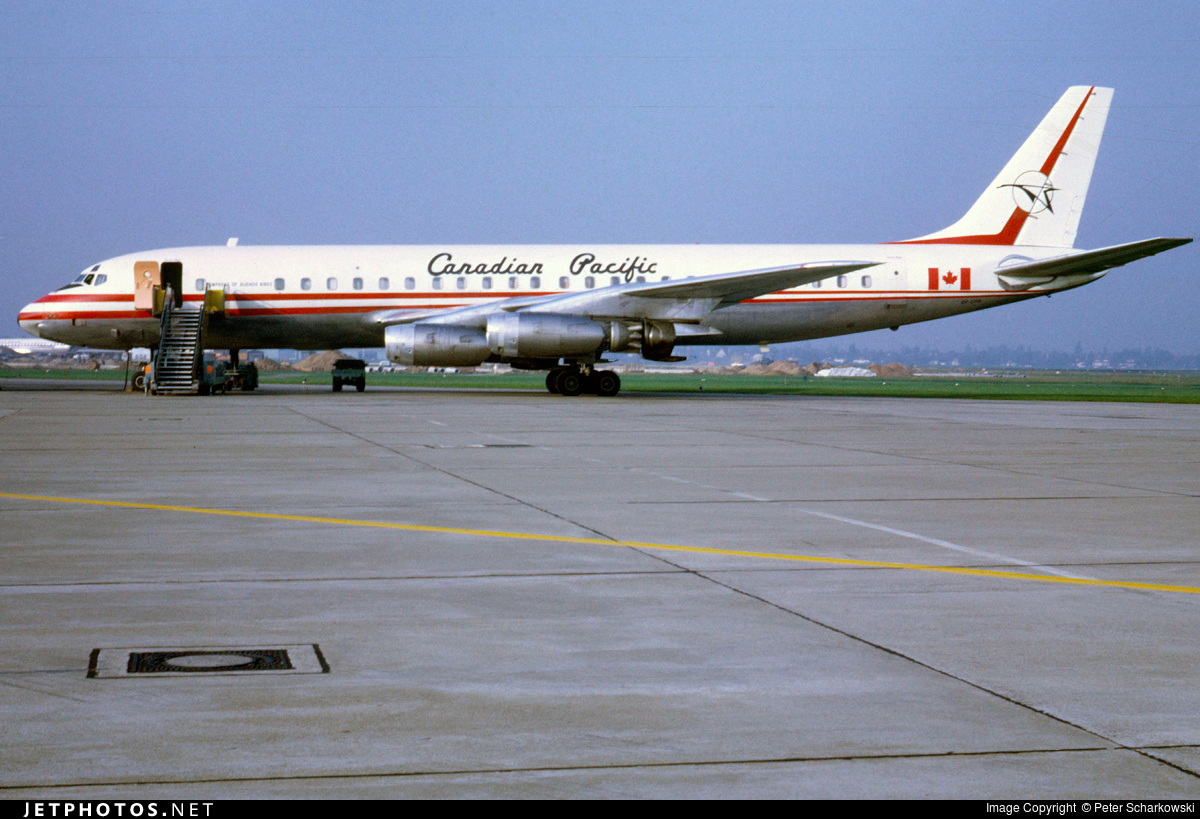
On 21 August 1961, a Douglas DC-8-43, N9604Z, c/n 45623, Line Number 130, flown by Chief Test Pilot William Marshall Magruder, Paul Patten, Joseph Tomich and Richard H. Edwards climbed to 50,090 feet (15,267 meters) near Edwards Air Force Base. Placing the DC-8 into a dive, it reached Mach 1.012 (668 miles per hour/1,075 kilometers per hour) while descending through 41,088 feet (12,524 meters). The airliner maintained this supersonic speed for 16 seconds. This was the first time that a civil airliner had “broken the Sound Barrier.”
An Air Force F-100 Super Sabre and F-104 Starfighter were chase planes for this flight. Reportedly, the F-104 was flown by the legendary test pilot, Colonel Chuck Yeager.

The Douglas DC-8 is a commercial jet airliner, a contemporary of the Boeing 707 and Convair 880. It was operated by a flight crew of three and could carry up to 177 passengers. The DC-8 was powered by four turbojet or turbofan engines mounted on pylons suspended below the wings. The wings’ leading edges were swept to 30°, as was the vertical fin and horizontal tailplane.
The DC-8-40 series is 150 feet, 6 inches (45.872 meters) long with a wingspan of 142 feet, 5 inches (43.409 meters) and overall height of 42 feet, 4 inches (12.903 meters). It had an empty weight of 124,790 pounds (56,604 kilograms) and maximum takeoff weight of 315,000 pounds (142,882 kilograms).
The DC-8-40 series had a cruising speed of 0.82 Mach (542 miles per hour/872 kilometers per hour) at 35,000 feet (10,668 meters). Its maximum range was 5,905 nautical miles (6,795 statute miles, 10,936 kilometers).
N9604Z was powered by four Rolls-Royce Conway RCo.12 Mk 509 two-shaft axial-flow turbofan engines, rated at 17,500 pounds of thrust (77.844 kilonewtons) at 9,990 r.p.m. The 509 is 11 feet, 3.9 inches (3.452 meters) long, 3 feet, 6.2 inches (1.072 meters) in diameter, and weighs 4,542 pounds (2,060 kilograms).
N9604Z was delivered to Canadian Pacific Airlines 15 November 1961, re-registered CF-CPG, and named Empress of Montreal. It later flew under CP Air as Empress of Buenos Aires. The DC-8 was scrapped at Opa Locka Municipal Airport, north of Miami, Florida, in May 1981.
© 2016, Bryan R. Swopes
The Empress of Buenos Aires was also the name of a DC-6-B that crashed near 100 Mile House in British Columbia when it was still Canadian Pacific Airlines.
My uncle Jack (John) Steele was the captain, everyone was killed on board by a bomb in the lavatory tank, (which seperated the tail section) by someone on board who the RCMP think put it there for an insurance claim on his death. .
This took place on July 8, 1965
It seems a bit confusing to me….
Good morning, Bruce. The name Empress of Buenos Aires has been used for several Canadian Pacific airplanes. A Bristol Type 175 Britannia 314, CF-CZA, s/n 13393, carried the name, before being renamed Empress of Hong Kong. The airplane flown by your uncle, Douglas DC-6B CF-CUQ, s/n 43844, assumed the name in 1959. The Mach 1 DC-8-43, CF-CPG, s/n 45623, had been called Empress of Montreal before being renamed Empress of Buenos Aires. From 1979, it was the name of CP Air’s Douglas DC-10-30 C-GCPE, s/h 46542.
Bryan, has any other “conventional” airliner ever attained Mach 1 other than the Concords and their Russian cousins?
Good question, Ernest. We know of course, that Global Airlines Flight 33, a Boeing 707, went supersonic in an episode of the “Twilight Zone,” [Season 2, Episode 18, “The Odyssey of Flight 33.”] 🙂 But there may have been some that did so briefly and inadvertently. I have read that during testing, a Boeing 727 reached 0.965 Mach in level flight, though I have not seen documentation. I believe that currently, the fastest airliner is the Boeing 747-8i, with a Vmo of 0.92 Mach.
According to an article in The Chicago Tribune (20 December 1992) Israeli Aircraft Industries flew a Boeing 747 to 0.98 Mach in an 18° dive from 36,000 feet,on 30 September 1992. The article also reported:
“Tim Cole, a spokesman at Boeing Commercial Airplane Co., said original flight tests of 747s conducted in 1969 and 1970 took 747-100 models to speeds of Mach 0.99.
“In addition, Boeing knows of one case in which a 747 operated by Evergreen International made and emergency descent at speeds that exceeded Mach 1, he said. . .
“As for the freighter that flew 0.98 Mach, Israel Aircraft reports it’s for sale, with an extensive overhaul. . . .”
Re: the Evergreen 747-100, The Seattle Times reported that Dave McNair, investigator for the Transportation Safety Board of Canada, “. . . could not confirm reports that it reached Mach 1.25, because precise information from the flight-data recorder was not immediately available.” “At some point during the incident three large panels beneath the leading edge of the right wing tore off, leaving a 3-by-15-foot hole on the forward, inboard section of the right wing. . . The panels damaged the right flap and dented the right-side forward edge of the horizontal tail section. . . Upon landing, part of the left flap came of as well. . . .”
I’m not surprised the 747 is capable of higher subsonic speeds. As I understand it the hump wasn’t a feature added for the intent of additional passenger space, it was to incorporate the “area rule,” which reduces turbulence at transonic and subsonic speeds, especially .75-1.25 mach. This would give the 747 a higher available subsonic speed without the associated problems that normally produces.
Without a chase plane with an airspeed system designed for speeds out past M1.0 or a flight test airspeed system installed, I would take any accounts of a large transport category jet going M1.0+ with a grain of salt. Production airspeed systems are only certified out to MFC (Maximum speed for stability characteristics, usually MMO+0.01), beyond that they tend to diverge from reality in the conservative direction (reading high) so the airplane might be at M0.98 but indicate M1.0+ due to this inaccuracy.
The chase plane was a supersonic Lockheed F-104A Starfighter, reportedly flown by Chuck Yeager. The Douglas DC-8 test flight specifically included the Mach 1 dive. Presumably, it was appropriately instrumented for the flight. You may doubt the speed reached, but TDiA will let you take that up with Captain Magruder and the Douglas flight test engineering staff. Captain Magruder won the Iven Kincheloe Award for the Society of Experimental Test Pilots. You might be interested in this: For a DC-8-62, when the Mach Meter indicates .85, the True Mach is .856 (normal static source), or .873 (alternate static source). MMO for the DC-8-50/62, -62 and -63 is 0.88 Mach.